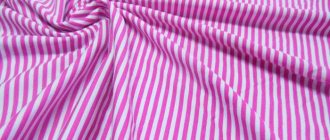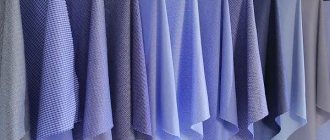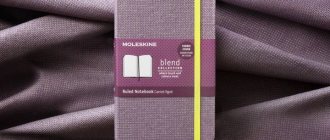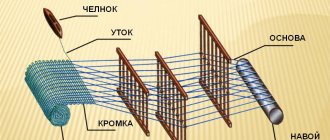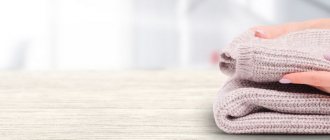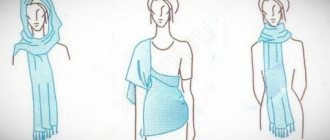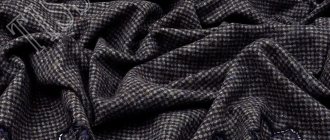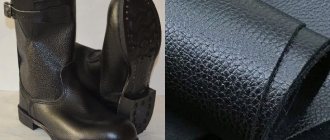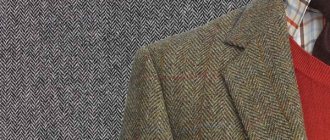Jacket material
Modern models are made from a variety of fabrics, including: natural, natural and mixed fibers. These products are made from wool, cashmere, cotton, as well as linen and matting. One of the popular models are jackets made of mixed fabrics in a combination of cotton and polyester. An interesting solution would be jackets made of worsted fabrics.
Types of jackets
Currently, there are several types of jackets:
- single-breasted and double-breasted (these products have two rows of buttons, lapels are of medium width and are fastened with an overlap. In this case, the lower flap is fastened with an internal button - a jigger. A distinctive feature of this type is the natural line of the shoulders and vents, thanks to which they are comfortable to wear)
- classic jacket (these models are considered one of the most popular and in demand; they have an open turn-down collar, virtually no decorative elements, including patch pockets, and a straight cut. These models go well with classic trousers.
- blazer (this is a club jacket, monocolor fabric is used for tailoring, there are patch pockets without metal buttons. As a rule, these products are not used with trousers; they go well with jeans)
- tailcoat (this type is used, as a rule, for attending any special or festive event. The most popular colors are black and dark blue. Knee length is one of the characteristic features of these models)
- tuxedo (a black or dark-colored jacket that has lapels made of smooth fabric and a deep neckline that reveals the chest. Pants with stripes, a black bow tie and a white shirt go well with a tuxedo).
- French (these products have a long and semi-long jacket with shoulder straps, perfectly harmonizes with formal business and office style. These jackets are distinguished by a soft collar and patch pockets. It should be noted that the width of the cuff and cuff is adjustable using tabs.
- women's jackets (came into fashion relatively recently, around the 1930s. Today, women's models are amazingly suitable for creating a formal business style and transform the image of any woman)
- jacket (women's fitted jacket of short length made of wool or light knitted fabric. Distinctive features: lapels can be of absolutely any size. In order to distinguish a jacket from other types, you need to pay attention to the general similarities. Jackets have much in common with a short coat.
Summer jacket: choosing fabric, cut and design
Many men whose office has a strict dress code are terrified of how they can survive the summer heat without drowning in a puddle of sweat. Meanwhile, even in summer you can look elegant and feel comfortable. To do this, just order a light jacket or a full suit with a lightweight lining, and choose the appropriate fabric for it. The content of the article
- What fabrics are summer suits made from?
- alfresco wool
- Cool linen
- Pure cotton
- Seersucker - "seal cotton"
- Cut and design of a summer jacket
- What color jacket to wear in summer
What fabrics are summer suits made from?
Obviously, fabric for summer should be quite thin and light (without compromising its appearance), with a loose weave of threads, which allows air to pass through and sweat to wick away. For sewing summer men's suits, these are the fabrics chosen from cotton, linen, silk or wool fiber. Then you will not be afraid of the need to leave the office and be overcome by the desire to quickly get to the nearest air conditioner.
alfresco wool
Especially for the summer season, almost all manufacturers of classic fabrics for men's suits create collections of “tropical” or “fresco wool” (not to be confused with frescoes, which are painted on wet plaster!). These are materials made from thin wool thread, heavily twisted, which gives it strength, and woven using open weave technology, which gives it a loose structure.
Often linen or silk is added to woolen thread. In the first case, the fabric holds its shape more clearly, in the second it has a soft flowing effect. For example, the Dormeuil brand has a collection of Callipso (up to 13% linen), Tropical Amadeus. As a rule, these are fabrics with a thickness of Super 120 and higher (the higher the number, the thinner the thread).
The term “alfresco” itself in Italian means “fresh”, “airy”, which reflects the main property of such woolen fabric - it does not absorb, but lets sweat pass from the body, leaving it fresh. A fresco wool suit will always keep you looking classy, no matter the heat or humidity.
Men's jacket in Fresco fabric
Cool linen
Linen fabrics are the most popular option for summer jackets and suits due to their breathable properties. They are light, hold their shape, and slightly cool the skin. The fabric has a pleasant natural texture and clear weave. The main disadvantage of linen is that the fabric made from it wrinkles.
This is true, but it also emphasizes the naturalness of the fabric and gives the suit a certain character, informal elegance. This is not considered a disadvantage, but still, men's jackets and suits made of linen are usually made in a sporty, casual casual style - loose fit, with patch pockets. Cotton is often added to linen fabric in a proportion of up to 40%. This makes the material softer, more flexible, and less wrinkled.
Options for linen jackets
Pure cotton
A universal option for a summer jacket is cotton fabric.
Cotton fibers are processed in such a way as to remove excess “lint” from them, so the material is dense and smooth. At the same time, it retains all valuable qualities: softness, breathability, absorbency. You can make any suit or jacket from cotton: formal, sporty or casual. It wrinkles less than linen and fits the figure well. This is the perfect suit for hot sunny days and humid tropical heat. Pair a cotton suit with a solid shirt or T-shirt and loafers for a casual weekend look.
Cotton jacket options
Seersucker - "seal cotton"
This fabric deserves special attention, if only because in America they even established a special holiday in its honor. It is celebrated on one Thursday in mid-June. This is a cotton, slightly corrugated, light striped fabric, also called “milk and sugar”. The history of its origin dates back to 1800.
Options for jackets made from Seersucker fabric The fabric is so well suited to the hot and humid climate of the southern American states that with the light hand of Mississippi Senator Trent Lott, the Senate began to wear seersucker suits every Thursday of the summer. With the advent of air conditioners, the fabric became less relevant, and television people complained about it - it is not very expressive under the camera (but it is very comfortable and practical). Therefore, since 2012, this tradition has been revived and even National Seersucker Day was declared.
Cut and design of a summer jacket
Even if you choose an excellent fabric, its benefits can be reduced by such tailoring features of men's jackets as the presence of sizing canvas in the chest area and lining. The canvas gives the jacket its shape, and the lining allows it to glide easily over the shirt as you put it on. No matter how thin the lining material is, be it twill, viscose or even silk, they still reduce the breathability of the jacket.
Therefore, the summer version of the suit is often sewn “without lining,” which means two options.
- Option “butterfly” or “quarter” A jacket without any lining will be uncomfortable. Although the fabric will be breathable, the shirt will bunch up under the sleeves, which will spoil the appearance of the jacket. Therefore, a compromise is used: lining on the shoulders and completely in the sleeve, the seams are edged to look neat.
- "Half-lining." Woven jackets have lining in the upper back and sides, the lower part of the jacket is single.
Alternatives to lining: butterfly or quarter lining (left) and half lining (right) A jacket without a canvas lining is called unstructured. Another feature of a summer jacket: reduced thickness of shoulder pads or their complete absence. Here everyone chooses the option that best suits their figure. Even minimal shoulder pads make the silhouette clearer and the relief of the shoulder more expressive.
What color jacket to wear in summer
It is obvious that the traditional colors of a business suit: blue, gray, graphite will remain even in the summer wardrobe. However, along with them, the following are good in summer: light gray, blue, khaki, sand, beige. Traditional patterns: check, stripe serve not only stylistic, but functional purposes. They subtly mask the imperfections of an unstructured jacket or blazer.
Frequently chosen shades of summer jackets: blue and cream. This year, burgundy and purple have become popular colors for men's suits. For a weekend occasion, you can sew such a non-trivial jacket or blazer. In addition, in summer, brighter tones and colors are generally acceptable - they look natural and break the brutality of the male image.
Frequently chosen shades of summer jackets: lilac and cream with blue stripes. Have we convinced you that a traditional jacket remains the best type of clothing for a man in summer? Choose the right fabric, order custom tailoring from a good studio, and regardless of the time of year you will look courageous and elegant.
Advantages of jackets
These products have many advantages; thanks to the wide range, they can be found in any person’s wardrobe. Let's give an example of the main advantages of jackets:
- versatility (these models can be successfully combined with both trousers and jeans. Today you can choose almost any color of fabric for sewing jackets, so everyone can choose the most suitable option)
- high quality
- hypoallergenic (jackets do not cause any allergic reactions and do not emit unpleasant odors)
- have a luxurious appearance (the jacket is guaranteed to transform any person’s image, bringing formality and status)
- can be used both for every day and for any festive or social event
- practicality (depending on the fabric that is included in these products, care may vary; jackets made from mixed fibers do not accumulate dust and dirt and do not require any additional care efforts)
- durability (modern jackets have a long service life; if treated with care and proper care, they will last for more than a year)
- high levels of hygroscopicity and wear resistance (these models withstand various impacts with dignity, while maintaining their appearance and all the positive qualities)
- ideal for business meetings
Types of materials
Suit fabric is a huge assortment of heterogeneous fabrics, with its own classification:
| Classification | Description |
| by color | plain dyed, with prints, multi-colored, bleached |
| by fiber type | synthetic, cotton, wool blend, wool, linen |
| by type of fiber weave | large-patterned (jacquard), fine-patterned, complex, combined |
| by structure | melange, shaped, twisted, textured |
Classified by gender. For women, lighter, flowing materials are used. Men's models are often made from half-wool or woolen raw materials.
Among men's suiting fabrics, the leaders are shanzhan and herringbone, and among women's - jacquard.
According to their purpose, models are distinguished for special occasions (dressy), special, for every day and branded. According to the price range, they are divided into premium (expensive natural) and budget (for everyday wear, with the addition of synthetic fibers).
By composition
The composition of the suit fabric can be completely natural, synthetic or mixed. The most popular suits are woolen. The material allows air to pass through and maintains optimal heat exchange. Thanks to the air gap between the fibers, wool absorbs and immediately evaporates moisture. Durable, not afraid of exposure to ultraviolet rays, practically does not wrinkle.
To give new characteristics, fibers of synthetic origin are added to wool. Most often, lavsan is used (from 30% to 60%). To make the fabric shine, add nylon or viscose threads. Wool-blend materials are even more durable, do not shrink, do not require special care and are cheaper for the consumer.
Natural raw materials for sewing suits are linen and cotton. But they are rarely used in their pure form, due to the high cost and increased creasing. Polyester fibers, viscose, nylon and others can be added to them.
Names of suit fabrics
Half-woolen and woolen fabrics for men's and women's suits:
- cashmere (threads made from down and wool from sheep in the highlands of India and Nepal), a hypoallergenic material that is not prone to pilling;
- gabardine (merino wool), obtained using twill weave, the material has a characteristic diagonal rib structure;
- tights, with a herringbone pattern, are most often used for sewing classic jackets with leather inserts on the elbows;
- tweed, with a small pile and a herringbone pattern;
- crepe, with a grainy structure.
Diagonal - fabric with a diagonal weave for a suit.
Among linen fabrics for sewing suits, materials with matting weave are most often used. The surface has a clear texture, the interweaving of fibers is clearly expressed in a checkerboard pattern, reminiscent of burlap.
Author:
Anastasia Kukushkina
I hope you enjoy the article I have prepared for you! If you find errors in it, write to me about it! I will answer any questions you have, ask them!
